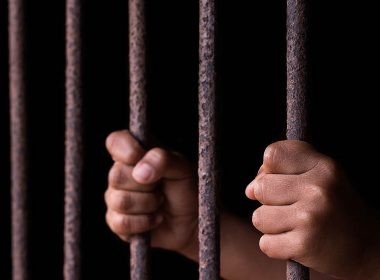Policies and protocols to manage gun possession by domestic violence perpetrators are not hitting the mark. Recent tragedies and gun ownership statistics highlight the shortocomings.
On June 30, the US Supreme Court agreed to decide whether a 1994 federal law that prohibits people under domestic violence restraining orders from possessing firearms is in violation of the Constitution’s Second Amendment.
The 1994 law currently in dispute prohibits a person subject to a domestic violence restraining order from possessing a firearm. It initially made the crime punishable by up to 10 years in prison and this term has since been raised to 15 years.
President Joe Biden’s administration had lodged an appeal against the lower court’s ruling that the law violated the Second Amendment’s “right to keep and bear arms”. The case that raised the conflict concerned a Texas man charged with illegal gun possession while subject to a domestic violence restraining order his girlfriend, obtained after he had physically assaulted her.
The case will be heard in October during the court’s next term.
This comes at a time when the issues of gun violence and pre-election political division in the US are particularly amplified. In June 2022, a landmark ruling on expanded gun rights (New York State Rifle & Pistol Association v. Bruen) overruled New York State’s limits on carrying concealed handguns outside the home. That ruling upheld that the Second Amendment protects an individual’s right to carry a handgun in public for self-defence.
Guns and domestic violence: a snapshot
According to the 2018 report by the Australian Institute of Health and Welfare on family, domestic and sexual violence in Australia, gunshot wounds were the third most common cause of death for Australian victims of domestic homicide.
The NSW Greens obtained private firearms ownership data through a Freedom of Information application to the NSW Police in 2021, which showed the overall number of guns and gun owners in NSW overall and by postcode between 2017 and 2019.
The total number of registered guns in NSW, including those registered to clubs, collectors and dealers, increased by 11 per cent from 920,000 in December 2016 to 1,022,740 in December 2020.
Here are some statistics for Sydney suburbs:
- The suburbs with the highest number of guns were Camden, in the city’s south-west, with 8050 guns, and Bligh Park, in the west, with 7700 registered guns.
- Camden recorded 316 domestic violence assaults between January and December 2022.
- The person with the largest individual arsenal, a Cremorne resident, had 419 guns.
- An arsenal of 305 guns was owned by a resident of Eastgardens.
- A Mosman resident had 297 guns.
Elsewhere in NSW, a gun owner in Goulburn had 300 guns.
Data supplied by the Bureau of Crime Statistics and Research in NSW shows that the number of domestic violence assault incidents where a firearm was recorded in NSW has steadily decreased over the last 20 years (8.2 per cent decline per year on average). The rate has remained stable over the last five years. In the 12 months to March 2023 there were 13 incidents of domestic violence assaults involving firearms, compared to 66 incidents in the 12 months to March 2004.
In NSW, in the 12 months to March 2023 there were 13 incidents of domestic violence assaults involving firearms, compared to 66 incidents in the 12 months to March 2004.
Landmark case shatters illusions of safety
On 5 July 2018, John Edwards, 67, shot and murdered his children Jack, 15, and Jennifer Edwards, 13, before killing himself at his own home in West Pennant Hills, Sydney. The pursuant coronial inquest found that he had “carefully and meticulously” planned the murder at the home the children shared with their mother, Olga. Olga had begun family court proceedings against John, which had resulted in the family going into hiding. John located them by stalking his young daughter from school, and the children’s bodies were found slaughtered under a desk where they had tried to hide from him. Olga died by suicide six months later.
The coronial inquest examined why John was granted gun permits and licences, despite his history of domestic violence and apprehended violence orders involving at least six former partners.
In the 12 months leading up to the shootings, Edwards had legally acquired five weapons. Olga made two reports to police about John’s conduct, including his violence towards their son Jack, with the details erroneously recorded by a senior constable. The inquest heard that the two reports did not correctly identify John, meaning they did not show up on his police record when he applied for a gun licence.
Amongst the recommendations made, the Firearms Registry supported recommendations that included changes to processes to ensure domestic violence is identified and considered during applications for firearm licences. It was also deemed a requirement for staff to consider whether applicants have provided false or misleading information in their application.
Seven of the recommendations directed at the NSW government were also supported, including implementing a new firearms regulation that will require applicants for firearm licences to disclose if they are engaged in family law proceedings.
Fit to be granted a gun licence?
LSJ spoke to Liam McKibbin, Senior Associate in Criminal Law at Armstrong Legal in NSW, about the existing laws and policies regarding domestic violence and firearm possession, and whether the US case ought to prompt a tightening of the legal framework to protect victims of domestic violence and prevent perpetrators having access to lethal weapons.

McKibbin says that no legislative reforms have taken place since the coronial inquest and its recommendations, but changes to police protocols and systems have occurred.
Prior to joining Armstrong Legal, McKibbin worked for five years as a constable at Kings Cross Local Area Command, and began working as a Senior Prosecutor with the NSW Police Force in June 2014. He acknowledges that his experience allows him to appreciate the complexities within the police administrative systems and the Firearms Registry leading up to the Edwards tragedy and similar tragedies.
McKibbin tells LSJ, “In my view, with regard to legislation and how the Firearms Registry is supposed to work to participate and engage with stakeholders such as the police, it is strict; in a perfect world – as the coronial inquest focused on – Mr. Edwards should not have been granted a firearms licence and therefore gone on to get as many firearms as he did.”
He adds, “The findings highlighted a systemic failure within the Firearms Registry and their engagement with the NSW Police to get the information they needed to apply the statutory test as to whether someone should be granted a licence or not.”
McKibbin notes that at the time Edwards made the application Firearms Registry staff were not receiving formal training on how to apply the legislation beyond the mandatory questions such as: “are you currently the subject of a personal violence or domestic violence offence?”
He says, “The first basis of the test is that firearms registry staff must be satisfied the applicant is a fit and proper person who can be trusted to have possession of firearms. That doesn’t purely take into account the mandatory questions; it’s something that should be a fact-finding mission to come to a global and conclusive opinion.”
NSW firearms laws and domestic violence
Domestic violence can have serious implications for the holder of a firearms licence or prohibited weapons permit in NSW. Laws governing this are contained in the Firearms Act 1996 (NSW), the Weapons Prohibition Act 1998 (NSW) and the Law Enforcement (Powers and Responsibilities) Act 2002.
Under sections 85 to 86 of the Law Enforcement (Powers and Responsibilities) Act, a police officer who enters a home to investigate a domestic violence offence must ask if there are firearms on the premises. If there are, the officer must take all reasonable action to search for and seize them. This action must be taken regardless of who owns the firearms.
Firearms that are seized must be taken to a police station and stored there, and the police must photograph the firearms to document their description and condition, and notify the Firearms Registry that the firearms have been seized.
Firearms that are seized must be taken to a police station and stored there, and the police must photograph the firearms and notify their seizure.
If the firearms licence of the person whose firearms have been seized is not suspended, the person has 28 days from the seizure of the firearms to apply for their return. The application must be made in writing to the Commander of the Police Area or Police District. Any unclaimed firearms can be forfeited to the Crown.
“When I was operational in Kings Cross between 2009 and 2014,” says McKibbin, “I went to my fair share of domestic-related matters. Every police officer does, and in fact they’re generally your bread and butter [work], unfortunately. In my experience, while asking the question that we have to ask under section 85, ‘are there firearms here?’ and ‘do you have a firearms licence?’, I never had a ‘yes’, which is not surprising given where I was working. Anecdotally, from former colleagues, you’re probably coming across firearms quite a bit in Forbes, Parkes, Broken Hill, Wagga Wagga, and Albury, where recreational shooting is more common.”
Suspending a firearms licence
A firearms licence must be suspended if a domestic violence offence has been committed or threatened, or the licence holder is charged with a domestic violence offence.
The suspension takes effect when a Notice of Suspension is served. The notice states the grounds for suspension and can be served by police or by post.
If the licence holder becomes subject to an interim Apprehended Domestic Violence Order (ADVO), the firearms licence will automatically be suspended until the order is confirmed or revoked.
In that suspension period, a person must not use or possess firearms or prohibited weapons, and any firearms or prohibited weapons and the associated licence or permit must be surrendered to police. Police also have the power to seize them. The items will remain with police until the suspension is lifted or the licence or permit is reinstated.
There is no right to review a licence-suspension decision to the Firearms Registry or NSW Civil and Administrative Tribunal (NCAT), but a letter can be sent to the Police Commissioner, via the Firearms Registry, to argue against licence revocation.
Staff training the best shot for safety
Anyone subject to an ADVO or an interim ADVO, or who has been subject to an ADVO in the 10 years prior, cannot be issued a firearms licence or prohibited weapon permit. A Notice of Refusal is issued by the Firearms Registry and states the reason for refusal. There is no right of review of a decision to refuse a licence based on the person being subject to an ADVO.
Any firearms or prohibited weapons and the associated licence or permit must be surrendered to police. Police also have the power to seize them.
McKibbin says, “I think the legislation is strict, but the problem with it in the Edwards case and other cases is that the people seemingly applying the legislation weren’t necessarily au fait with how to go about doing that.
These systems are put into place, along with legislation, but it’s entirely dependent on the people entrusted with adjudicating it and exercising the powers conferred under it. It reinforces the point that you have to have professionally trained staff at the Firearms Registry, and well-educated, informed police officers who know what their duties are and – importantly – are recording how they go about their duties. Police for the last couple of decades have streamlined to remove human error as much as possible.”
‘You have to have … well-educated, informed police officers who know what their duties are and … are recording how they go about their duties.’
In October 2021, the recommendations made by the NSW State Coroner, Teresa O’Sullivan, following the Edwards coronial inquest, were unanimously supported. The NSW police supported all five recommendations directed at them, which encompass the development of mandatory training for general officers responding to domestic violence. This could could include specific modules on recording and reporting incidents correctly.
Police said they would also look to train shift supervisors to be aware of verification requirements around domestic violence incidents, and developed a 15-module domestic violence training course that incorporates family law.
The Firearms Registry also supported recommendations that included changes to processes to ensure domestic violence is identified and considered during applications for firearm licences, and that false or misleading information by applicants is identified.
Delia Donovan, CEO of Domestic Violence NSW (DVNSW), says, “I would argue that there are missing accountabilities and so much more needs to be done to assert communication and information sharing to safeguard lives. This cannot be swept under the carpet and needs to be addressed urgently.”
In the wake of the Edwards coronial inquest report and the recommendations that resulted, Donovan says, DVNSW supports improving NSW police practice to increase safety to women and children at risk of harm, including improving training and monitoring the implementation of procedures; improving firearms regulation in order to protect victim/survivors of domestic and family violence; addressing poor policing practice of domestic and family violence matters where there is an active Family Court matter; and improving information sharing processes to safeguard lives.




